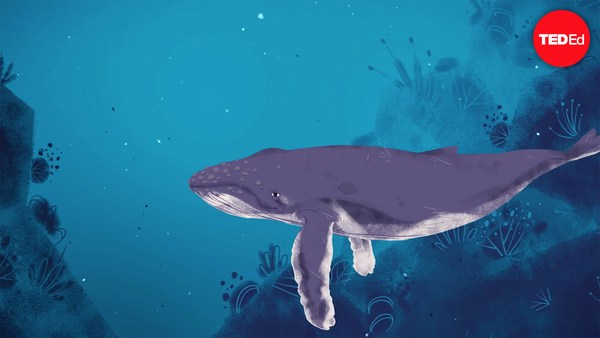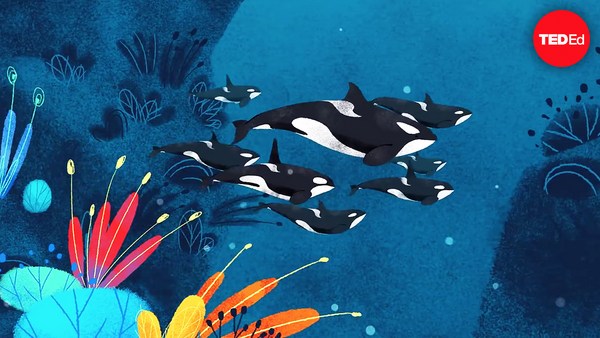Thank you so much. I'm going to try to take you on a journey of the underwater acoustic world of whales and dolphins. Since we are such a visual species, it's hard for us to really understand this, so I'll use a mixture of figures and sounds and hope this can communicate it. But let's also think, as a visual species, what it's like when we go snorkeling or diving and try to look underwater. We really can't see very far. Our vision, which works so well in air, all of a sudden is very restricted and claustrophobic. And what marine mammals have evolved over the last tens of millions of years is ways to depend on sound to both explore their world and also to stay in touch with one another.
Dolphins and toothed whales use echolocation. They can produce loud clicks and listen for echoes from the sea floor in order to orient. They can listen for echoes from prey in order to decide where food is and to decide which one they want to eat. All marine mammals use sound for communication to stay in touch. So the large baleen whales will produce long, beautiful songs, which are used in reproductive advertisement for male and females, both to find one another and to select a mate. And mother and young and closely bonded animals use calls to stay in touch with one another, so sound is really critical for their lives.
The first thing that got me interested in the sounds of these underwater animals, whose world was so foreign to me, was evidence from captive dolphins that captive dolphins could imitate human sounds. And I mentioned I'll use some visual representations of sounds. Here's the first example. This is a plot of frequency against time -- sort of like musical notation, where the higher notes are up higher and the lower notes are lower, and time goes this way. This is a picture of a trainer's whistle, a whistle a trainer will blow to tell a dolphin it's done the right thing and can come get a fish. It sounds sort of like "tweeeeeet." Like that. This is a calf in captivity making an imitation of that trainer's whistle. If you hummed this tune to your dog or cat and it hummed it back to you, you ought to be pretty surprised. Very few nonhuman mammals can imitate sounds. It's really important for our music and our language.
So it's a puzzle: The few other mammal groups that do this, why do they do it? A lot of my career has been devoted to trying to understand how these animals use their learning, use the ability to change what you say based on what you hear in their own communication systems. So let's start with calls of a nonhuman primate. Many mammals have to produce contact calls when, say, a mother and calf are apart. This is an example of a call produced by squirrel monkeys when they're isolated from another one. And you can see, there's not much variability in these calls. By contrast, the signature whistle which dolphins use to stay in touch, each individual here has a radically different call. They can use this ability to learn calls in order to develop more complicated and more distinctive calls to identify individuals.
How about the setting in which animals need to use this call? Well let's look at mothers and calves. In normal life for mother and calf dolphin, they'll often drift apart or swim apart if Mom is chasing a fish, and when they separate they have to get back together again. What this figure shows is the percentage of the separations in which dolphins whistle, against the maximum distance. So when dolphins are separating by less than 20 meters, less than half the time they need to use whistles. Most of the time they can just find each other just by swimming around. But all of the time when they separate by more than 100 meters, they need to use these individually distinctive whistles to come back together again. Most of these distinctive signature whistles are quite stereotyped and stable through the life of a dolphin. But there are some exceptions.
When a male dolphin leaves Mom, it will often join up with another male and form an alliance, which may last for decades. As these two animals form a social bond, their distinctive whistles actually converge and become very similar. This plot shows two members of a pair. As you can see at the top here, they share an up-sweep, like "woop, woop, woop." They both have that kind of up-sweep. Whereas these members of a pair go "wo-ot, wo-ot, wo-ot." And what's happened is they've used this learning process to develop a new sign that identifies this new social group. It's a very interesting way that they can form a new identifier for the new social group that they've had.
Let's now take a step back and see what this message can tell us about protecting dolphins from human disturbance. Anybody looking at this picture will know this dolphin is surrounded, and clearly his behavior is being disrupted. This is a bad situation. But it turns out that when just a single boat is approaching a group of dolphins at a couple hundred meters away, the dolphins will start whistling, they'll change what they're doing, they'll have a more cohesive group, wait for the boat to go by, and then they'll get back to normal business. Well, in a place like Sarasota, Florida, the average interval between times that a boat is passing within a hundred meters of a dolphin group is six minutes. So even in the situation that doesn't look as bad as this, it's still affecting the amount of time these animals have to do their normal work.
And if we look at a very pristine environment like western Australia, Lars Bider has done work comparing dolphin behavior and distribution before there were dolphin-watching boats. When there was one boat, not much of an impact. And two boats: When the second boat was added, what happened was that some of the dolphins left the area completely. Of the ones that stayed, their reproductive rate declined. So it could have a negative impact on the whole population. When we think of marine-protected areas for animals like dolphins, this means that we have to be quite conscious about activities that we thought were benign. We may need to regulate the intensity of recreational boating and actual whale watching in order to prevent these kinds of problems. I'd also like to point out that sound doesn't obey boundaries. So you can draw a line to try to protect an area, but chemical pollution and noise pollution will continue to move through the area.
And I'd like to switch now from this local, familiar, coastal environment to a much broader world of the baleen whales and the open ocean. This is a kind of map we've all been looking at. The world is mostly blue. But I'd also like to point out that the oceans are much more connected than we think. Notice how few barriers there are to movement across all of the oceans compared to land. To me, the most mind-bending example of the interconnectedness of the ocean comes from an acoustic experiment where oceanographers took a ship to the southern Indian Ocean, deployed an underwater loudspeaker and played back a sound. That same sound traveled to the west, and could be heard in Bermuda, and traveled to the east, and could be heard in Monterey -- the same sound.
So we live in a world of satellite communication, are used to global communication, but it's still amazing to me. The ocean has properties that allow low-frequency sound to basically move globally. The acoustic transit time for each of these paths is about three hours. It's nearly halfway around the globe. In the early '70s, Roger Payne and an ocean acoustician published a theoretical paper pointing out that it was possible that sound could transmit over these large areas, but very few biologists believed it.
It actually turns out, though, even though we've only known of long-range propagation for a few decades, the whales clearly have evolved, over tens of millions of years, a way to exploit this amazing property of the ocean. So blue whales and fin whales produce very low-frequency sounds that can travel over very long ranges. The top plot here shows a complicated series of calls that are repeated by males. They form songs, and they appear to play a role in reproduction, sort of like that of song birds. Down below here, we see calls made by both males and females that also carry over very long ranges.
The biologists continued to be skeptical of the long-range communication issue well past the '70s, until the end of the Cold War. What happened was, during the Cold War, the U.S. Navy had a system that was secret at the time, that they used to track Russian submarines. It had deep underwater microphones, or hydrophones, cabled to shore, all wired back to a central place that could listen to sounds over the whole North Atlantic. And after the Berlin Wall fell, the Navy made these systems available to whale bio-acousticians to see what they could hear.
This is a plot from Christopher Clark who tracked one individual blue whale as it passed by Bermuda, went down to the latitude of Miami and came back again. It was tracked for 43 days, swimming 1,700 kilometers, or more than 1,000 miles. This shows us both that the calls are detectable over hundreds of miles and that whales routinely swim hundreds of miles. They're ocean-based and scale animals who are communicating over much longer ranges than we had anticipated.
Unlike fins and blues, which disperse into the temperate and tropical oceans, the humpbacked whales congregate in local traditional breeding grounds, so they can make a sound that's a little higher in frequency, broader-band and more complicated. So you're listening to the complicated song produced by humpbacks here. Humpbacks, when they develop the ability to sing this song, they're listening to other whales and modifying what they sing based on what they're hearing, just like song birds or the dolphin whistles I described. This means that humpback song is a form of animal culture, just like music for humans would be.
I think one of the most interesting examples of this comes from Australia. Biologists on the east coast of Australia were recording the songs of humpbacks in that area. And this orange line here marks the typical songs of east coast humpbacks. In '95 they all sang the normal song. But in '96 they heard a few weird songs, and it turned out that these strange songs were typical of west coast whales. The west coast calls became more and more popular, until by 1998, none of the whales sang the east coast song; it was completely gone. They just sang the cool new west coast song. It's as if some new hit style had completely wiped out the old-fashioned style before, and with no golden oldies stations. Nobody sang the old ones.
I'd like to briefly just show what the ocean does to these calls. Now you are listening to a recording made by Chris Clark, 0.2 miles away from a humpback. You can hear the full frequency range. It's quite loud. You sound very nearby. The next recording you're going to hear was made of the same humpback song 50 miles away. That's shown down here. You only hear the low frequencies. You hear the reverberation as the sound travels over long-range in the ocean and is not quite as loud. Now after I play back these humpback calls, I'll play blue whale calls, but they have to be sped up because they're so low in frequency that you wouldn't be able to hear it otherwise. Here's a blue whale call at 50 miles, which was distant for the humpback. It's loud, clear -- you can hear it very clearly. Here's the same call recorded from a hydrophone 500 miles away. There's a lot of noise, which is mostly other whales. But you can still hear that faint call.
Let's now switch and think about a potential for human impacts. The most dominant sound that humans put into the ocean comes from shipping. This is the sound of a ship, and I'm having to talk a little louder to talk over it. Imagine that whale listening from 500 miles. There's a potential problem that maybe this kind of shipping noise would prevent whales from being able to hear each other. Now this is something that's been known for quite a while.
This is a figure from a textbook on underwater sound. And on the y-axis is the loudness of average ambient noise in the deep ocean by frequency. In the low frequencies, this line indicates sound that comes from seismic activity of the earth. Up high, these variable lines indicate increasing noise in this frequency range from higher wind and wave. But right in the middle here where there's a sweet spot, the noise is dominated by human ships. Now think about it. This is an amazing thing: That in this frequency range where whales communicate, the main source globally, on our planet, for the noise comes from human ships, thousands of human ships, distant, far away, just all aggregating.
The next slide will show what the impact this may have on the range at which whales can communicate. So here we have the loudness of a call at the whale. And as we get farther away, the sound gets fainter and fainter. Now in the pre-industrial ocean, as we were mentioning, this whale call could be easily detected. It's louder than noise at a range of a thousand kilometers. Let's now take that additional increase in noise that we saw comes from shipping. All of a sudden, the effective range of communication goes from a thousand kilometers to 10 kilometers. Now if this signal is used for males and females to find each other for mating and they're dispersed, imagine the impact this could have on the recovery of endangered populations.
Whales also have contact calls like I described for the dolphins. I'll play the sound of a contact call used by right whales to stay in touch. And this is the kind of call that is used by, say, right whale mothers and calves as they separate to come back again. Now imagine -- let's put the ship noise in the picture. What's a mother to do if the ship comes by and her calf isn't there? I'll describe a couple strategies.
One strategy is if your call's down here, and the noise is in this band, you could shift the frequency of your call out of the noise band and communicate better. Susan Parks of Penn State has actually studied this. She's looked in the Atlantic. Here's data from the South Atlantic. Here's a typical South Atlantic contact call from the '70s. Look what happened by 2000 to the average call. Same thing in the North Atlantic, in the '50s versus 2000. Over the last 50 years, as we've put more noise into the oceans, these whales have had to shift. It's as if the whole population had to shift from being basses to singing as a tenor. It's an amazing shift, induced by humans over this large scale, in both time and space.
And we now know that whales can compensate for noise by calling louder, like I did when that ship was playing, by waiting for silence and by shifting their call out of the noise band. Now there's probably costs to calling louder or shifting the frequency away from where you want to be, and there's probably lost opportunities. If we also have to wait for silence, they may miss a critical opportunity to communicate. So we have to be very concerned about when the noise in habitats degrades the habitat enough that the animals either have to pay too much to be able to communicate, or are not able to perform critical functions. It's a really important problem.
And I'm happy to say that there are several very promising developments in this area, looking at the impact of shipping on whales. In terms of the shipping noise, the International Maritime Organization of the United Nations has formed a group whose job is to establish guidelines for quieting ships, to tell the industry how you could quiet ships. And they've already found that by being more intelligent about better propeller design, you can reduce that noise by 90 percent. If you actually insulate and isolate the machinery of the ship from the hull, you can reduce that noise by 99 percent. So at this point, it's primarily an issue of cost and standards. If this group can establish standards, and if the shipbuilding industry adopts them for building new ships, we can now see a gradual decline in this potential problem.
But there's also another problem from ships that I'm illustrating here, and that's the problem of collision. This is a whale that just squeaked by a rapidly moving container ship and avoided collision. But collision is a serious problem. Endangered whales are killed every year by ship collision, and it's very important to try to reduce this. I'll discuss two very promising approaches. The first case comes from the Bay of Fundy. These black lines mark shipping lanes in and out of the Bay of Fundy. The colorized area shows the risk of collision for endangered right whales because of the ships moving in this lane. It turns out that this lane here goes right through a major feeding area of right whales in the summer time, and it makes an area of a significant risk of collision. Well, biologists who couldn't take no for an answer went to the International Maritime Organization and petitioned them to say, "Can't you move that lane? Those are just lines on the ground. Can't you move them over to a place where there's less of a risk?" And the International Maritime Organization responded very strongly, "These are the new lanes." The shipping lanes have been moved. And as you can see, the risk of collision is much lower.
So it's very promising, actually. We can be very creative about thinking of different ways to reduce these risks. Another action which was just taken independently by a shipping company itself was initiated because of concerns the shipping company had about greenhouse gas emissions with global warming. The Maersk Line looked at their competition and saw that everybody who is in shipping thinks time is money. They rush as fast as they can to get to their port. But then they often wait there. What Maersk did is they worked ways to slow down. They could slow down by about 50 percent. This reduced their fuel consumption by about 30 percent, which saved them money, and at the same time, it had a significant benefit for whales. It you slow down, you reduce the amount of noise you make and you reduce the risk of collision.
So to conclude, I'd just like to point out, you know, the whales live in an amazing acoustic environment. They've evolved over tens of millions of years to take advantage of this. And we need to be very attentive and vigilant to thinking about where things that we do may unintentionally prevent them from being able to achieve their important activities. At the same time, we need to be really creative in thinking of solutions to be able to help reduce these problems. I hope these examples have shown some of the different directions we can take in addition to protected areas to be able to keep the ocean safe for whales to be able to continue to communicate.
Thank you very much.
(Applause)





